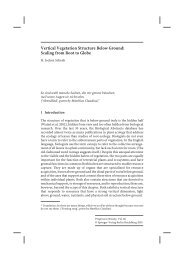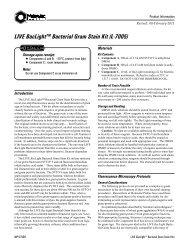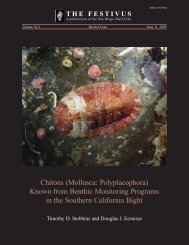Landscape Evolution at an Active Plate Margin - Biological Science ...
Landscape Evolution at an Active Plate Margin - Biological Science ...
Landscape Evolution at an Active Plate Margin - Biological Science ...
You also want an ePaper? Increase the reach of your titles
YUMPU automatically turns print PDFs into web optimized ePapers that Google loves.
aine deposits. The Convict Lake basin lies between<br />
the two mountain masses. The basin is <strong>an</strong> excellent<br />
example of a U-shaped glacial valley.<br />
As is the case with m<strong>an</strong>y glacial deposits throughout<br />
the Sierras, there has been signific<strong>an</strong>t disagreement<br />
as to the ages of the Convict Creek moraines. Blackwelder<br />
was the first to study <strong>an</strong>d interpret age rel<strong>at</strong>ionships<br />
of these deposits when he visited the area<br />
in the 1920s. Subsequently, others have examined the<br />
Convict Creek moraines with a variety of interpret<strong>at</strong>ions<br />
as to their age rel<strong>at</strong>ionships (see Lipshie, 2001<br />
for a discussion of these interpret<strong>at</strong>ions). RETRACE<br />
to Hwy 395.<br />
73.6 (0.1) TURN LEFT (north) on 395.<br />
75.0 (1.4) TURN RIGHT on Hot Creek/Fish H<strong>at</strong>chery<br />
Road, the paved road to Hot Creek.<br />
75.2 (0.2) Pass a right turn to Mammoth/June Lake<br />
airport (Airport Road).<br />
75.5 (0.3) TURN RIGHT on Hot Creek H<strong>at</strong>chery<br />
Road.<br />
75.9 (0.4) Pass the fish h<strong>at</strong>chery,<br />
where they use he<strong>at</strong>ed w<strong>at</strong>er from<br />
Hot Creek to raise the fish. The Hot<br />
Creek Fish H<strong>at</strong>chery is down the<br />
gravel road to the left. While not<br />
the most geologic of stops, children<br />
really love it! Near the h<strong>at</strong>chery,<br />
geothermal springs mix with the<br />
w<strong>at</strong>er from Hot Creek. The result<br />
is a series of ponds th<strong>at</strong> maintain<br />
year-round temper<strong>at</strong>ure of 55 to<br />
63°F, <strong>an</strong> ideal environment for incub<strong>at</strong>ing<br />
trout eggs <strong>an</strong>d raising fish.<br />
The h<strong>at</strong>chery, run by the California<br />
Department of Fish <strong>an</strong>d Game, has<br />
been in oper<strong>at</strong>ion since the early<br />
1930s. Children love to feed the<br />
fish (costs a quarter), but stick your<br />
h<strong>an</strong>d in the w<strong>at</strong>er <strong>at</strong> your own risk!<br />
76.1 (0.2) We are driving over a l<strong>at</strong>e<br />
D. R. Jessey <strong>an</strong>d R. E. Reynolds<br />
Table 2-3. Glacial Sequences of the Eastern Sierra Nevada<br />
North Americ<strong>an</strong><br />
(modified from Lipshie, 2001)<br />
Blackwelder Sharp <strong>an</strong>d Birm<strong>an</strong> Lipshie (2001) Absolute Age<br />
Sequence<br />
(1931)<br />
(1963)<br />
(years B.P.)<br />
M<strong>at</strong>thes<br />
0-700<br />
Post-Wisconsin<br />
Recess Peak<br />
2000-4000<br />
L<strong>at</strong>e Wisconsin<br />
Early Wisconsin<br />
Illinoi<strong>an</strong><br />
K<strong>an</strong>s<strong>an</strong><br />
Nebrask<strong>an</strong><br />
Tioga<br />
Tahoe<br />
-<br />
Sherwin<br />
McGee<br />
Tioga<br />
Tenaya - Tahoe<br />
Mono Basin<br />
Sherwin<br />
McGee<br />
Hilgard<br />
Tioga<br />
Tenaya- Tahoe<br />
Mono Basin<br />
Sherwin<br />
McGee<br />
9000-10,500<br />
12,000-25,000<br />
45,000-75,000<br />
About 130,000<br />
About 800,000<br />
1,500,000-2,500,000<br />
Qu<strong>at</strong>ernary fault scarp th<strong>at</strong> had minor<br />
additional offset in 1980. This linear,<br />
low scarp cutting l<strong>at</strong>e Pleistocene basalt<br />
is one of several pre-existing faults th<strong>at</strong><br />
ruptured <strong>at</strong> the surface during the 1980<br />
earthquake swarm; this one possibly is a<br />
splay of the Hilton Creek fault. Extension<br />
cracks appeared on Hot Creek<br />
Road trending in a northwest–southeast<br />
direction <strong>at</strong> the base of the southwest-facing fault<br />
scarp. Extension varied from 0.5 to 3 inches, with individual<br />
cracks reaching 15 to 20 feet in length. Vertical<br />
displacement r<strong>an</strong>ged from 6 inches to about one<br />
foot. Field mapping <strong>an</strong>d fault pl<strong>an</strong>e solutions suggest<br />
extension, but the actual displacement mech<strong>an</strong>ism is<br />
complex, possibly involving magma movement.<br />
76.7 (0.6) Road bears left <strong>at</strong> T-intersection <strong>an</strong>d pavement<br />
ends.<br />
78.2 (1.5) TURN LEFT into the Hot Creek Geologic<br />
Site parking area <strong>an</strong>d PARK.<br />
STOP 2-6. Hot Creek (37°39’38”N, 118°49’40”W).<br />
From the interpretive overlook, note the steam rising<br />
from fumaroles <strong>an</strong>d hot springs along the creek (Fig.<br />
2-7). Hot springs also discharge directly into Hot<br />
Creek near the remains of the bridge th<strong>at</strong> formerly<br />
sp<strong>an</strong>ned the creek. The mingling of hot spring w<strong>at</strong>er<br />
with snow-melt fed stream w<strong>at</strong>er produces extreme<br />
temper<strong>at</strong>ure gradients in the creek. The wide r<strong>an</strong>ge of<br />
Figure 2-7. View looking to the west along Hot Creek. Light-colored areas have been<br />
hydrothermally altered by geothermal w<strong>at</strong>ers. [Source: Farrar, Ev<strong>an</strong>s, Venezky, Hurwitz<br />
<strong>an</strong>d Oliver, 2007]<br />
38 2009 Desert Symposium
















